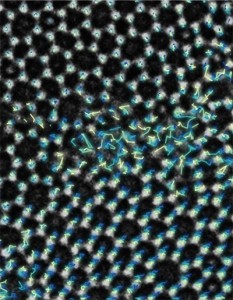
 Trajectories of atoms in the deforming glass overlaid on a transmission electron microscopy image. (Credit: P. Huang/Cornell.)
Trajectories of atoms in the deforming glass overlaid on a transmission electron microscopy image. (Credit: P. Huang/Cornell.)
A few weeks ago we reported on a molecule-thick sheet of glass accidentally produced at Cornell University being recognized as the world’s thinnest by the Guinness Book of World Records.
It didn’t take long for the researchers involved to get down to some more serious science with the silica glass, which was grown on a graphene substrate. Taking advantage of the material’s thinness, they have now directly imaged (and made a video of) atoms in the glass in the seconds before it shatters. The work, reported recently in Science, may eventually lead to first-principles design of glasses for strength or other properties.
A research team led by David A. Muller, professor of engineering physics and codirector of the Kavli Institute at Cornell for Nanoscale Science, and Ute Kaiser, professor at Germany’s University of Ulm, bent, deformed, and melted the glass—and observed the results—using a transmission electron microscope. In a news release, Muller describes the electron beam as “tickling” the glass to both cause deformation and image the results.
“We had all of these pictures of the glass, and when we strung them together into videos we were surprised to see the atoms wiggling and jiggling around,” graduate student Pinshane Huang explains in the release. “We realized that we were looking at the building blocks for how glass deforms.”
The snippet of video shows atoms rearranging in the glass, with different atomic behaviors in four different regions of the material. “Everyone thought it was impossible to see atoms moving in a glass, and suddenly we were able to do it with this new, ultrathin glass,” Huang says.
Watching as portions of the glass melted and formed moving boundaries under the electron beam, the researchers realized their molecule-thick material might be able to provide insight into the fundamental properties of glasses. “We don’t understand deeply why glasses are solid,” professor of physics and coauthor Jim Sethna says in the release. “An experiment that lets us watch it freeze could be revealing.”
